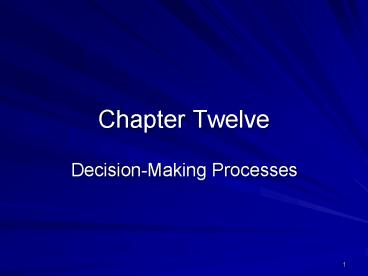Chapter Twelve - PowerPoint PPT Presentation
Title:
Chapter Twelve
Description:
Chapter Twelve Decision-Making Processes * * Today s Business Environment New strategies Reengineering Restructuring Mergers/Acquisitions Downsizing New product ... – PowerPoint PPT presentation
Number of Views:153
Avg rating:3.0/5.0
Title: Chapter Twelve
1
Chapter Twelve
- Decision-Making Processes
2
Todays Business Environment
- New strategies
- Reengineering
- Restructuring
- Mergers/Acquisitions
- Downsizing
- New product/market development
- . . . Etc.
3
Decisions Made Inside the Organization
- Complex, emotionally charged issues
- More rapid decisions
- Less certain environment
- Less clarity about means/outcomes
- Requires more cooperation
4
A New Decision-Making Process
- Required because
- no one person has enough info to make all major
decisions - No one person has enough time and credibility to
convince many - Relies less on hard data
- Guided by powerful coalition
- Permits trial and error approach
5
Steps in the Rational Approach to Decision-Making
6
Constraints and Trade-offs During Non-programmed
Decision-Making
Bounded Rationality Limited time,
information, resources to deal with
complex, multidimensional issues
Decision/ Choice Search for a high-quality decisi
on alternative
Trade-off
Personal Constraints Desire for prestige,
success personal decision style and the need
to satisfy emotional needs, cope with pressure,
maintain self-concept
Trade-off
Trade-off
Trade-off
Organizational Constraints Need for agreement,
shared perspective, cooperation, support,
corporate culture and structure, ethical values
Trade-off
Sources Adapted from Irving L. Janis, Crucial
Decisions (New York Free Press, 1989) and A.
L. George, Presidential Decision Making in
Foreign Policy The Effective Use of Information
and Advice (Boulder, Colo. Westview Press,
1980).
7
Choice Processes in the Carnegie Model
Uncertainty
Coalition Formation
Search
Hold joint discussion and interpret goals and
problems Share opinions Establish problem
priorities Obtain social support for problem,
solution
Conduct a simple, local search Use established
procedures if appropriate Create a solution if
needed
Information is limited Managers have many
constraints
Conflict
Managers have diverse goals, opinions,
values, experience
Satisficing
Adopt the first alternative that is
acceptable to the coalition
8
The Incremental Decision Process Model
- Identification Phase
- Recognition
- Diagnosis
- Development Phase
- Search
- Screen
- Design
- Selection Phase
- Judgment (evaluation choice)
- Analysis (evaluation)
- Bargaining (evaluation choice)
- Authorization
- Dynamic Factors
9
Learning Organization Decision Process When
Problem Identification and Problem Solution Are
Uncertain
PROBLEM IDENTIFICATION
PROBLEM SOLUTION
When problem identification is uncertain,
Carnegie model applies Political and social
process is needed Build coalition, seek
agreement, and resolve conflict about goals and
problem priorities
When problem solution is uncertain, Incremental
process model applies Incremental,
trial-and-error process is needed Solve big
problems in little steps Recycle and try again
when blocked
10
Illustration of Independent Streams of Events in
the Garbage Can Model of Decision-Making
Problems
Solutions
Middle Management
Problems Solutions Choice Opportunities Participa
nts
Participants
Participants
Choice Opportunities
Choice Opportunities
Solutions
Department A
Department B
Problems Solutions Choice Opportunities Participa
nts
Problems Solutions Choice Opportunities Participa
nts
Choice Opportunities
Problems
Participants
Solutions
Problems
Problems
Solutions
Participants
Participants
11
Contingency Framework for Using Decision Models
Problem Consensus
2
1
Certain
Individual Rational Approach
Computation Organization Management Science
Individual Bargaining, Coalition
Formation Organization Carnegie Model
Solution Knowledge
Individual Judgment Trial-and-error Organiza
tion Incremental Decision Process Model
Individual Bargaining and Judgment
Inspiration and Imitation Learning Organization
Carnegie and Incremental Decision Process
Models, Evolving to Garbage Can
4
3
Uncertain
12
Special Decision Circumstances
- High-Velocity Environments
- Decision Mistakes and Learning
- Escalating Commitment
13
Decision Styles
Workbook Activity
Your decisions Approach used Advantages and disadvantages Your recommended decision style
1.
2.
Decisions by others
1.
2.































